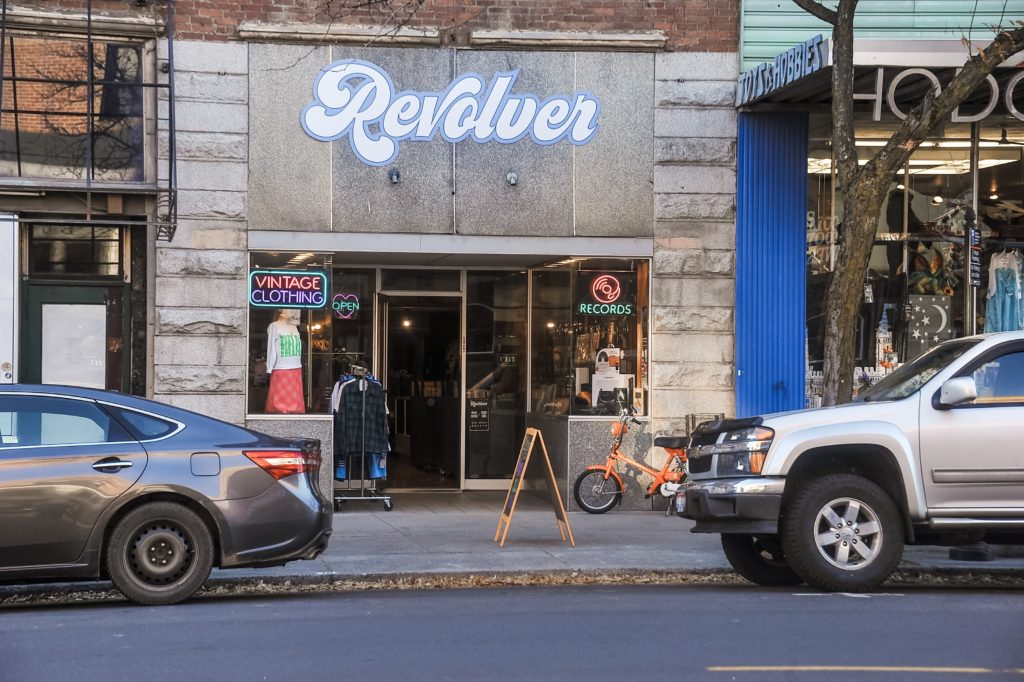Bold prints displayed in the Main Street shop’s windows draw in customers as they walk through downtown Moscow. Inside the store, racks of vintage clothing line the wood floors. Groovy music plays in the background as the shop’s patrons thumb through the large collection of vinyl records resting on the black shelves against the wall.
Courtney Siebken, co-owner of downtown Moscow’s newest vintage and record store, Revolver, welcomes all consumers with a relaxing atmosphere and unique clothing selection that seems to fit exactly what this store is.

With a colorful skirt made from ties, ripped-up denim jackets, and snazzy-looking jeans, Revolver has become the place to shop if you are looking for ways to reinvent your look. Using an ‘80s-inspired style, Siebken buys clothing items from friends and family she feels fits the look of Revolver and her customer base.
Although she’s now invested in researching and discovering new information about sustainable clothing and building Revolver’s selection, Siebken said she didn’t always have an interest in sustainable fashion. Rather, she started out on a very different career path.
Before beginning work on Revolver, Siebken was working in the tax department at a stock brokerage, a far cry from her current occupation. Siebken was initially drawn to environmentalism following her volunteer work planting trees, which in time jumpstarted her interest in sustainable clothing practices back in 2016.

Sustainable fashion brands, like Revolver, are represented in a growing trend in the fashion industry. Many are turning away from traditional clothing brands and moving toward buying fashion made of used and recycled materials to support and create ecological integrity. This decision is mostly fueled by a movement away from the harmful practices of fast fashion.
“Fast fashion can create many negative impacts in our environment, such as gas emissions and water pollution from all the toxic chemicals put into these clothing items,” Siebken said. “I only go to places like Ross if I want to get a pair of socks or something general. I try to shop in places like Storm Cellar and places in Seattle where I used to live.”
Fast fashion can lure consumers such as college students to purchase inexpensive clothing that replicates trends faster than the original brand itself.
The cost of this breakneck speed is often labor exploitations, gas emissions, water pollution, and toxic chemicals, making fast fashion a big contributor to environmental problems around the world.

Caitlin Suire, a University of Idaho student majoring in electrical engineering, said after she became aware of the negative impacts of fast fashion on the environment, she decided to start shopping sustainably at places like Goodwill and the Storm Cellar.
Suire said buying clothes sustainably and going thrifting not only reduces waste, supports the community, and helps you avoid fast fashion, but it also can act as a DIY project.
Suire said by altering the clothing she buys sustainably, she can be creative, pass the time, and make the items she buys more personalized.
“I remember I wanted a pair of shorts, so I bought some jeans at Goodwill and tried to make them my own,” Suire said. “I ended up liking them and (they) were worth more than what I would have spent on a new pair.”

While many like Suire and Siebken shop sustainably to combat environmental issues raised by fast fashion, Skyler Howell, a graduate student at UI, shops at antique stores and Goodwill to breathe life into used items.
“Most recently I bought a vintage strainer and took it apart for an art project,” Howell said. “My favorite part about that is being able to see something for what it’s not.”
Howell said he finds more value in repurposing items than buying them new.
“I find it more valuable to buy a particular item that is used and has meaningful memory than buying something brand new or online without a backstory to it,” Howell said. “Whether it’s worth buying or not, it gives you something to do and enjoy.”
He said while he does go to places like Storm Cellar and Revolver to shop for clothing, he likes to explore places like Goodwill instead to see what items are available for him to experiment with.

Sustainable buying comes in many forms, helping to stimulate growth, creativity, and sparking the interests of consumers. As fast fashion continues to grow, Siebken said it’s more important than ever for young adults to buy sustainably as much as possible.
“It’s important that you look into your favorite brand’s values,” Siebken said. “Make sure their values line up with yours and if they don’t, shop at places that do.”
Story by Monica Casas-Carrillo
Photos by Ryan Abajero
Design by Taylor Lund
